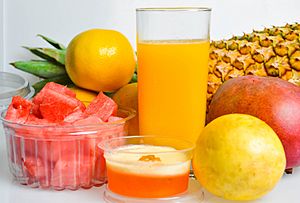Pineapple juice facts for kids
Pineapple juice is a sweet and tangy drink made by pressing the liquid from the inside of a pineapple. Pineapples are tropical fruits. Many types of pineapples can be used to make juice, like Smooth Cayenne, Red Spanish, Queen, and Abacaxi. When pineapple juice is made for stores, it is usually put into cans.
People drink pineapple juice on its own or mixed with other juices. It is also used in smoothies, cocktails, and to add flavor to food. You can even use it to make meat softer! Pineapple juice is a key ingredient in popular drinks like the piña colada and tepache.
Contents
The Story of Pineapple Juice
No one is completely sure how pineapples first arrived in Hawaii. Some stories say they washed ashore from a shipwreck, while others say sailors brought them. The fruit might have been there before Captain James Cook arrived in 1778. However, another story says Don Francisco de Paula Marin planted the first pineapple. Marin was a gardener who brought many new plants to Hawaii. He wrote about planting pineapples in his journals in 1813.
Pineapple juice became very important for the pineapple industry in the 1930s. In 1932, the Hawaiian Pineapple Company found a way to make the juice clear while keeping its great smell and taste. Growing many pineapples led to a group forming that set limits on how much whole, cut, or crushed pineapple could be canned. Even though they agreed on these limits in 1934, companies started canning pineapple juice more. This helped them find new ways to sell their products, especially as fruit juice became a popular breakfast drink.
How Pineapple Juice is Made
| Nutritional value per 100 g (3.5 oz) | |
|---|---|
| Energy | 251 kJ (60 kcal) |
|
15.7 g
|
|
| Sugars | 14.45 g |
| Dietary fiber | 0.8 g |
|
0.08 g
|
|
|
Protein
|
0.42 g
|
| Vitamins | Quantity
%DV†
|
| Thiamine (B1) |
9%
0.1 mg |
| Riboflavin (B2) |
2%
0.02 mg |
| Niacin (B3) |
2%
0.28 mg |
| Pantothenic acid (B5) |
2%
0.1 mg |
| Vitamin B6 |
5%
0.07 mg |
| Folate (B9) |
1%
5 μg |
| Choline |
1%
4.8 mg |
| Vitamin C |
11%
9.5 mg |
| Minerals | Quantity
%DV†
|
| Calcium |
1%
14 mg |
| Copper |
5%
0.09 mg |
| Iron |
2%
0.28 mg |
| Magnesium |
4%
14 mg |
| Manganese |
53%
1.12 mg |
| Phosphorus |
1%
6 mg |
| Potassium |
4%
122 mg |
| Sodium |
0%
1 mg |
| Zinc |
1%
0.10 mg |
| Other constituents | Quantity |
| Water | 83.5 g |
|
Link to USDA Database entry
|
|
| †Percentages estimated using US recommendations for adults. | |
Pineapple juice is made from pineapples that are fully ripe. First, the pineapples are cleaned using brushes and sprays. This removes dirt, spots, and any leftover pesticides. After cleaning, the fruit goes into a special machine that peels it and takes out the pulp. This pulp then goes into another machine that squeezes out the juice. A fine filter is used next to remove any solid bits, fibers, or tiny particles from the juice.
A machine called a vacuum degasser removes air from the pineapple juice. Taking out the air stops solid parts from floating to the top. It also helps prevent too much foam when the juice is packaged. The juice is then heated in a heat exchanger to make it safe to drink. This process, called pasteurization, also stops the enzymes that can make the juice turn brown. After being heated, the juice is cooled down to about 50 degrees Celsius (122 degrees Fahrenheit).
The pasteurized pineapple juice is stored in large iron drums. These drums have special bags inside made of aluminum and plastic to keep the juice fresh. Once cooled, the juice is put into bottles or cans using a filling machine.
You can also find pineapple juice in powder form. This powder is made by spraying pineapple juice onto tapioca maltodextrin and letting it dry.
What's in Pineapple Juice?
Pineapple juice is mostly water, about 84% of it! It has about 16% carbohydrates, which give you energy. It has very little fat and protein. In a small serving (100 ml or about 3.4 ounces), pineapple juice has 60 calories. It is a great source of manganese, giving you more than half of what you need each day. It also has a good amount of vitamin C.
Cooking with Pineapple Juice
Pineapple juice powder can be used in many recipes. You can add it to pies, cakes, muffins, and scones. It's also great for making chutneys, jams, chilis, candies, sauces, and stews. Pineapple juice powder can even be used to marinate chicken and fish, making them more tender and flavorful.
Where is Pineapple Juice Popular?
In 2016, countries in the European Union drank half of all the pineapple juice sold worldwide. The Netherlands was the biggest importer of pineapple juice in Europe that year. Thailand and Costa Rica were the main countries that supplied pineapple juice to the European Union in 2016. In 2017, the countries that drank the most pineapple juice were Thailand, Indonesia, and the Philippines. Together, they drank almost half of the world's total. Even though China and India have very large populations, they drink less pineapple juice compared to other countries.
Popular Pineapple Juice Drinks
- The tepache is a traditional drink made from the skin and core of pineapples. It also includes sugar cane and cinnamon.
- The piña colada is a famous cocktail. It is made with white rum, coconut cream, and pineapple juice.
See also
 In Spanish: Jugo de piña para niños
In Spanish: Jugo de piña para niños


